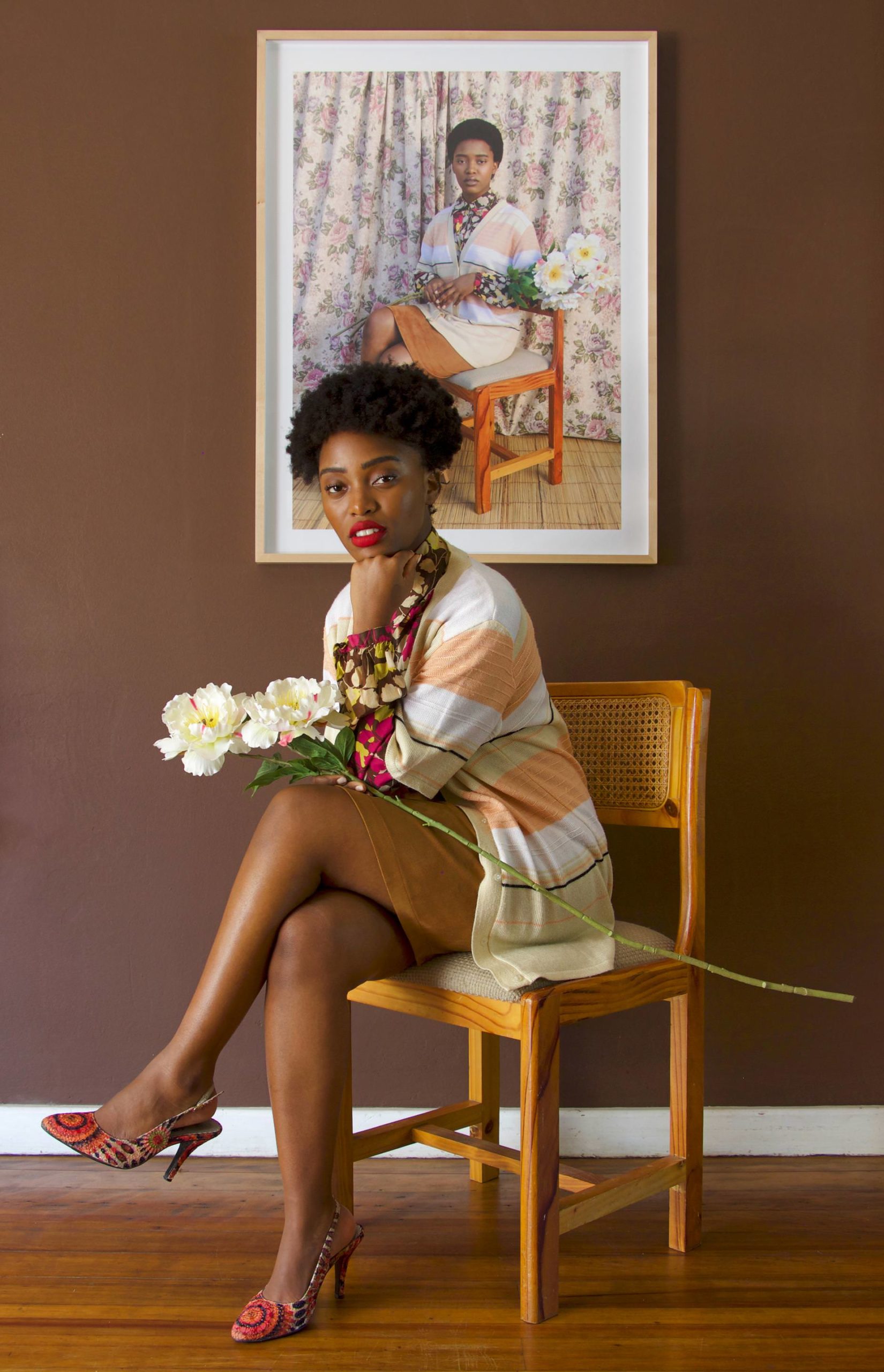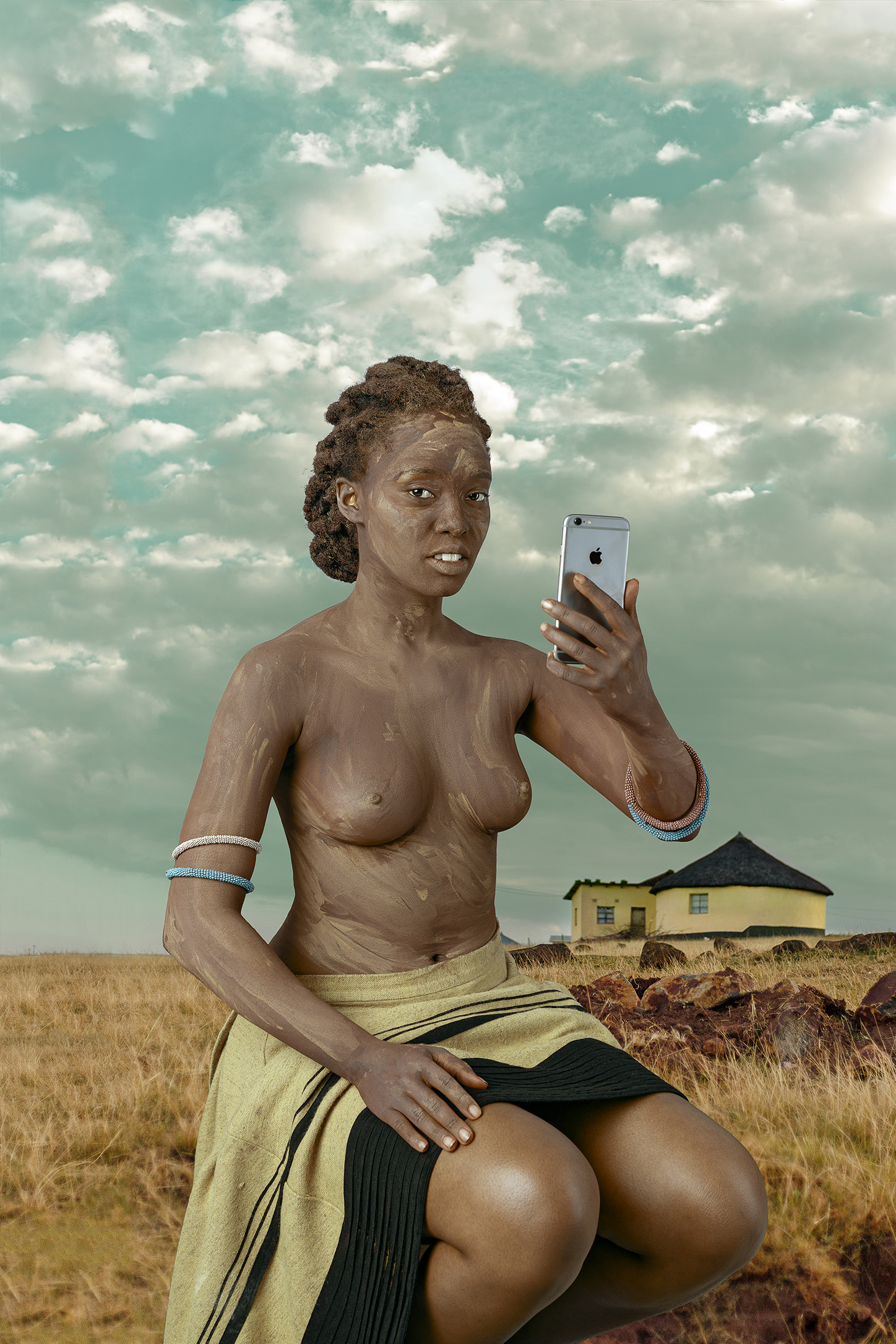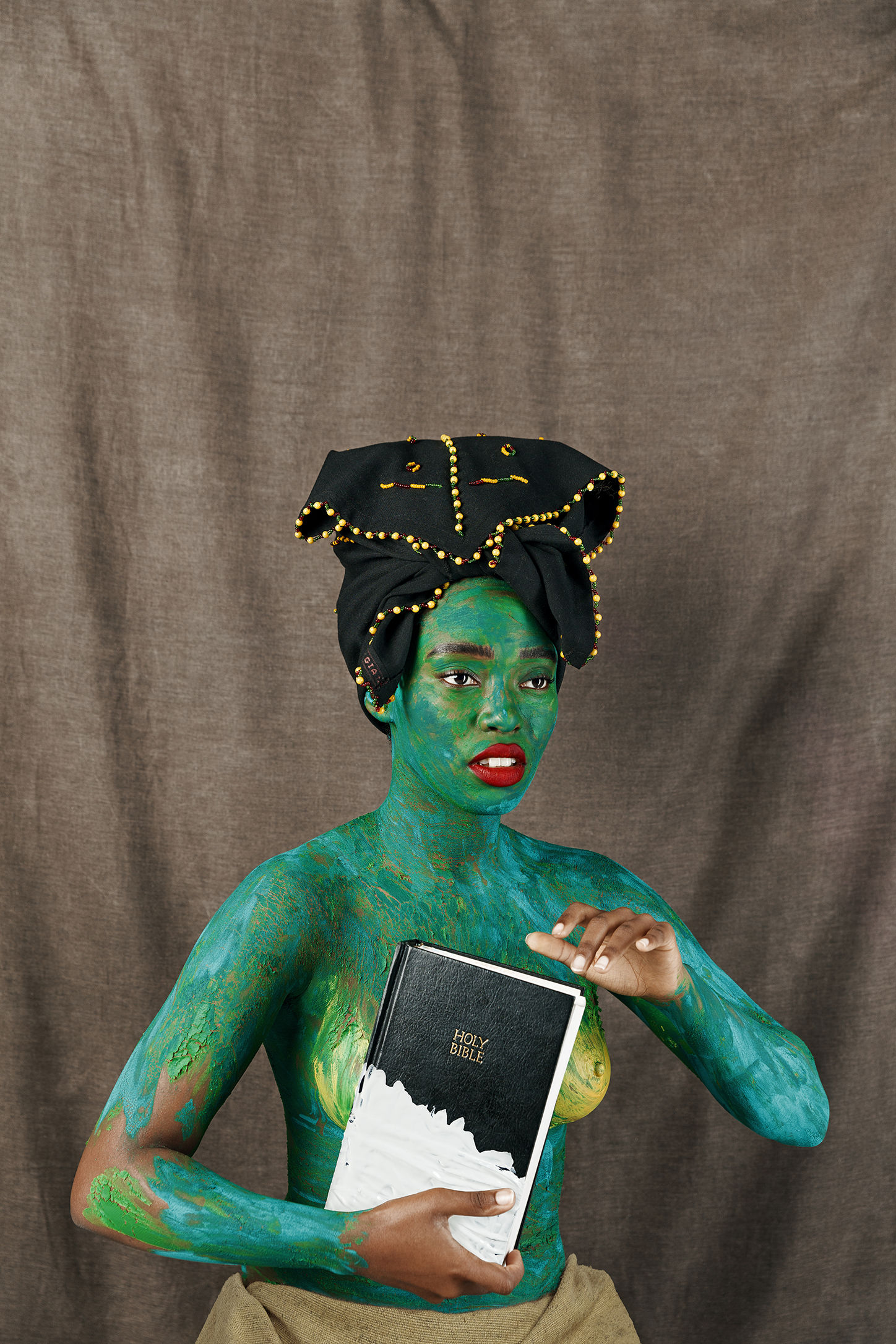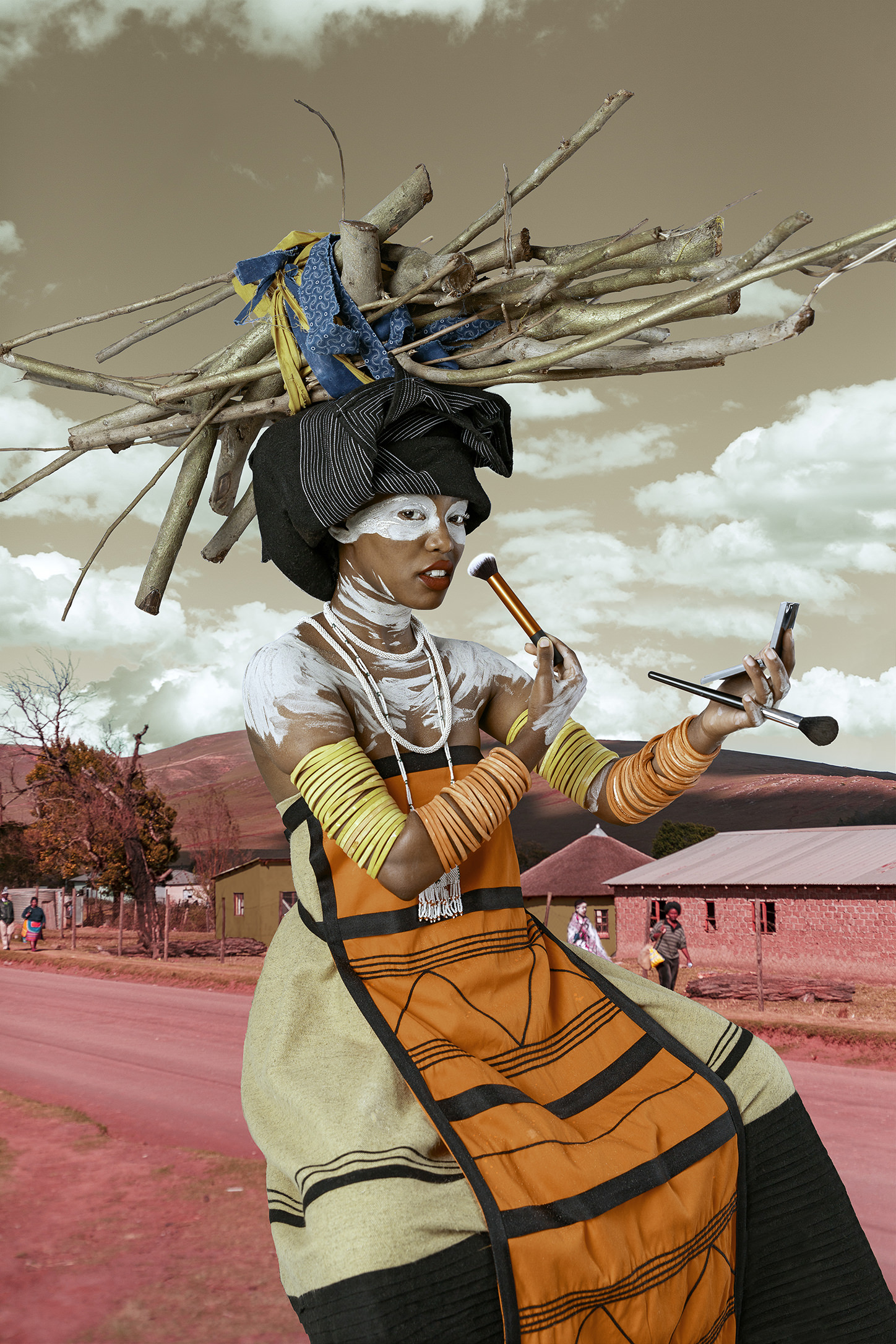Tony Gum prefers the title “artist in learning,” because she’d like to be an artist who is ever evolving, intentionally and with vulnerability. Her fresh- feeling self-portraits—posing with Coca-Cola products, with makeup reminiscent of Twiggy or Frida Kahlo—have garnered attention online and via Instagram for their rich, Wes Anderson–esque colors and Pop references. Just 22 years old, she won the 2017 PULSE Prize in Miami at the end of last year, and currently exhibits with Christopher Moller Gallery.
Her latest body of work, “Ode to She,” may be her most personal series yet. Growing up in the city of Cape Town, she decided to reconnect to her Xhosa roots and explore her family’s clan and culture. She homed in on traditions of identity, exploring the journey of a woman, from girl to elder.

Portrait by Noxolo Mafu.
At the start of 2018, Whitewall heard from Gum about why transformation is beautiful, and why her own evolution is a pending mem- oir.
WHITEWALL: What was the starting point for your “Ode to She” series, which recently won you the PULSE Prize in Miami at the end of last year?

Tony Gum
Xhosa Woman – uMfazi
2017
Courtesy of the artist
TONY GUM: The starting point for “Ode to She” was to reconnect with my Xhosa tradition and question its relevance to my modern-day reality. I took time to go back to the Eastern Cape, because I grew up in the city, to recon- nect with roots and to obtain insights about my family’s clan and Xhosa culture. I did this with the help of our Federal Department of Cooperative Governance and Traditional Affairs (COGTA), as well as the Eastern Cape’s House of Traditional Leaders, who arranged that I meet the women in the village and the esteemed Queens and Queen Mother of Pondos and abaThembu.
Our hosts welcomed us with warm hearts reminding me of our spirit of uBhuntu. They shared insights about certain beliefs, practices, and values enshrined in our Xhosa culture and identity. They expanded on the belief systems, language, and modalities of expressions—in other words, what it means to be a Xhosa girl (iNtombi), married woman (uMfazi), and elder (iXhegokazi) in our culture.

Tony Gum
Land of Milk & Honey
2017
Courtesy of the artist
WW: What was the most challenging piece for you in that series?
TG: It has to be portraying iXhegokazi and doing so in the most authentic way possible. Firstly, I have not arrived at this stage of my life, however I am now enlightened about how important the role of iXhegokazi is in preserving and transferring the intrinsics of our culture to generations to come.

Tony Gum
Xhosa Woman – iNtombi I
2017
Courtesy of the artist
Having spent time with several elders in the Eastern Cape, I not only listened to their stories but observed their practices, bodies, and expressions, amongst other things. This helped me construct and create the “figure” of iXhegokazi as you see it. Of course, like most things in our culture I had to get permission before portraying this figure, and they gave me their blessings. A part of me believes it is because of these blessings that I am able to create this work and to go on to win awards.
WW: How did you want to explore the experience of a Xhosa woman, the journey of a young woman as she evolves physically and spiritually?
TG: It was about interrogating certain misinterpretations women of my age have about our Xhosa culture whilst educating those that are not familiar with our practices. I had to draw from various personal experiences at church, family gatherings, and school where you will find that the youth is misunderstood, or vice versa. They say, “Siyaphendula” (put simply, we are rebellious), but they say this because they feel we are back-chatting because we feel that we understand more—or we feel that we have a right of expression to which our parents were not fortunate to have, .i.e., Apartheid expressed through taking one’s right to dignity, amongst other things. When we peel through the challenges of our past affecting both old and young, we can better understand our culture, its guiding principles, and the beauty that lies within it. That is why I choose to explore these experiences through my art.
WW: What about the act of transformation interests you?
TG: Transformation, like a butterfly, is beautiful! The process of metamorphosis can be related to our culture’s rite of passage. In “Ode to She,” I bring out the significant role played by each woman transitioning from iNtombi to iXhegokazi, and portraying the beauty they carry as they breed life and spirit to generations to come. The “girl” (iNtombi) and “woman” (uMfazi) ulti- mately arriving at life’s edge, the subtle balance and contrasts of life stages where delicacy and fortitude are embodied in the elderly woman’s posture (iXhegokazi), who holds fast to these indelible practices as forbearer and ultimate nurturer.
Through this work, I want to reiterate the representation and power of each woman, acknowledging all the women I have encountered throughout my journey. So I needed it to be a “poem,” a “song,” “a letter to she”. . . and I don’t mean “She” in the gender-confined or prescriptive sense. I speak of She, the Being, who understands He/She to be a force like nature, a person who has been beaten, battered, but is still able to rise.
WW: You’ve spoken about creating a message for your people, a message of African excellence, youth hustle, and the idea of working with what you’ve got. What do you want people to know about you and the generation of artists you represent?
TG: I want them to know that the evolution of Tony Gum is a pending memoir. That I am inspired by them as much as they are inspired by my work. We are in coexistence as our generation (youth) is revolutionizing tomorrow.
WW: For a while, you’ve said you were more comfortable with the label “creative” rather than “artist.” You still describe yourself as an artist in learning. Why make that distinction?
TG: I refer to myself as an “artist in learning” because I enjoy learning—it’s not necessarily to strip myself of a title. Learning is an ever-evolving notion and I would like to be an artist that is ever evolving—deliberately and vulnerably.
The artist has the ability to reflect on the past, speak of the present, and predict a future, all in one piece. The artist can evoke thought-leaders and provide a solution for a lost generation. What makes the role of being an artist serious is that an artist plays the role of a visual philosopher, and with that comes great responsibility.
WW: You’ve been working in series, from “Coca-Cola” to “Twiggy” to “Free Da Gum.” What are you currently exploring and experimenting with?
TG: I’m currently expanding the “Ode to She” narrative beyond experiencing it in 2-D. I’m a recent film and video technology graduate from the Cape Peninsula University of Technology, so I’ll be looking into documenting and compiling what I’ve already documented in 2-D.









